You wouldn’t imagine that a shrub that could be grown as a hedge could also live quite happily in a pot. Photinia Red Robins are one of those versatile plants that are equally beautiful both tall and small, with an attractive display of copper colour leaves (new growth) against a green backdrop of older leaves.
The combination is just lovely. In our how to grow and care guide, we’ll chat about the hybrid Photinia ‘Red Robin’, how to propagate your own shrub from cuttings, pests and diseases that affect this plant, and some frequently asked questions.
More...
Family: | Rosaceae |
|---|---|
Genus: | Photinia |
Hybrid: | Photinia × fraseri |
Cultivar: | ‘Red Robin’ |
Common Names: | Christmas berry |
Location: | Outdoor |
Type: | Shrub |
Growth: | 3 to 6 metres tall and wide |
Sun requirements: | Full or partial sun |
Foliage Colour: | Red |
Flower Colour: | White or cream |
Flowering: | Spring |
Fruit: | Small and red |
Maintenance level: | Low |
Poisonous for pets: | Yes |
Introducing Photinia Red Robins
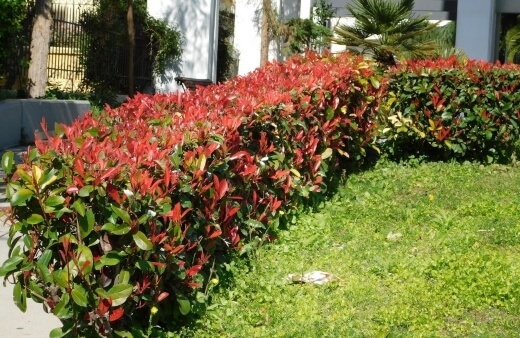
While this shrub does also produce flowers, the floral display has nothing on the red leaves that completely outshine them. This is why it’s considered the most popular cultivar of all the Photinia varieties. (See more Photinia varieties here). It’s even earned an award from the Royal Horticultural Society.
The Photinia ‘Red Robin’ earned its name because of the red tipped leaves that appear in springtime. Maybe part of the name inspiration was even a bird by the same name.
The Photinia family includes shrubs from Asia and North America. These evergreen plants are grown because of their beautiful coloured leaves and there are many hybrids available, like the Red Robin. This hybrid’s family roots can be traced back to Japan.
The new leaves of this shrub start off in a copper red colour and later become dark green as the growth establishes itself. The flowers that appear in spring are a cream white and after them comes a red fruit.
Photinia ‘Red Robin’ Hedge
Photinia ‘Red Robin’ makes a great hedge. Here’s a tip – if you want to keep that gorgeous red colour right through the summer, you can cut it when the growth starts to turn green and just keep up this process to produce more red leaves and a lovely bushy hedge.
If you don’t do any shaping, your shrub will take on a round shape with leaves that go all the way to the ground.
Australia has amazing native plants that are perfect to turn into hedges. If you’re looking to add some privacy to your garden, or decorate a fence, take a look at our Australian native hedge plants gardening guide to explore the varieties to choose from and our complete guide to growing the NSW Christmas bush which has become one of our top favourites.
How to Grow Photinia ‘Red Robin’
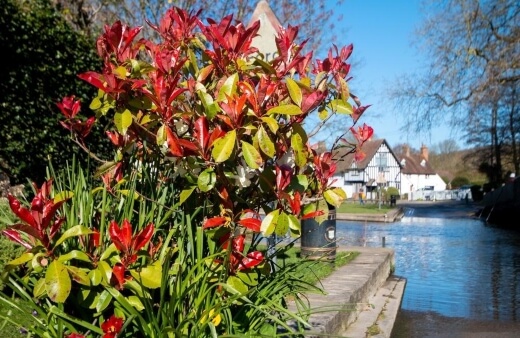
This shrub grows quite quickly. In terms of height it grows between 3 to 6 metres and the same range in terms of its width. Photinia ‘Red Robin’ loves summer rain and will really thrive in areas with generous summer rainfall.
If you’re in a drier area, then be sure to water your shrub often. Coastal regions are also a hit for this shrub, and tropical conditions not so much.
In winter time, Photinia ‘Red Robin’ can handle frost but mulch around the roots does help to prevent freezing. With the soil, you don’t want the shrub to sit in soggy turf.
In the same way mulching in winter protects the roots, you can do the same in summer to help keep them cool. You can prune your shrub in spring or summer if you want to reshape or resize it.
Propagating Photinia ‘Red Robin’
If you’ve decided that you want to add this lovely shrub to your own garden, propagation with cuttings is a fairly simple process. Here’s how you do it.


Get Your Free Guide:
Master Growing Australian Natives eBook
A Must Have Complete Guide for Every Australian Garden
Get Your Free Guide:
Master Growing Australian Natives eBook
A Must Have Complete Guide for Every Australian Garden
Late summer is the ideal time to take your cuttings and do it early in the morning. Snip off sections that are about 10cm long from healthy looking stems. You can cut it just below a leaf stem. A sharp knife is the easiest tool to use.
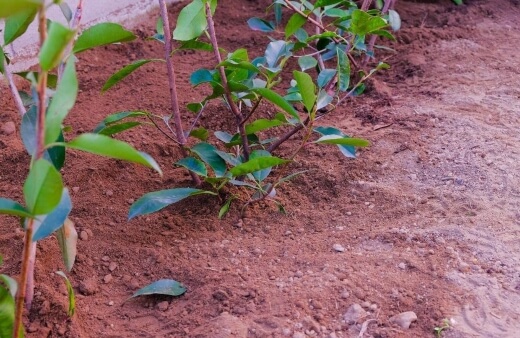
The best time to take the cuttings is late summer. If you take them too early, they are too soft and tend to rot. If you’re not planning to plant the cuttings straight away, you can wrap them in a wet paper towel and pop them in the fridge.
When you’re ready to plant, you can fill a pot/s with a rooting potting mix and water. Take the leaves off the lower half of the stem and plant it about 5cm deep, trying not to let the leaves touch the soil.
If you’re using a bigger pot, you can put a few cuttings in one. Place the pots in a plastic bag and tie it closed, without letting the bag touch the cutting.
In about three weeks, pull gently on the stems to check for resistance which means they have roots. Once they do, you can take the plastic bag off. You can now repot the cutting in normal potting soil and keep it inside until spring.
It will need a sunny spot and keep it out of a draft. If the soil feels dry you can then give it some water.
How to Care for Photinia ‘Red Robin’
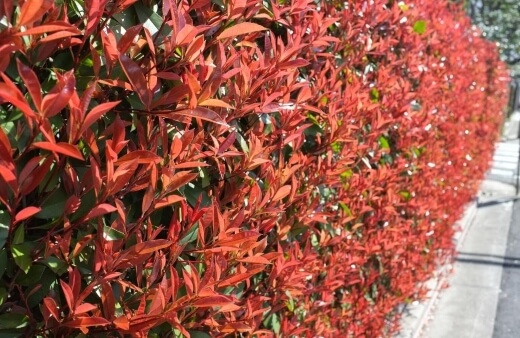
Sunlight Preference
Your Photinia ‘Red Robin’ needs full sun but partial shade is also fine. These shrubs can be grown in shadier conditions but then you might end up with a diseased plant on your hands.
Best Soil to Use
For optimum growing conditions, the Photinia ‘Red Robin’ needs well-draining soil that is neutral to slightly acidic. Make sure that air can flow around your plant to keep it healthy.
Watering Photinia ‘Red Robin’
This shrub is quite resistant to drought. That means a dryer soil is absolutely fine since the roots spread themselves to a decent depth to find the water they need.
When you water, aim for the soil and not the leaves of the plant. As a guideline, only water when you really need to – this would be in very hot and dry weather.
What Fertiliser to Use
When spring begins, you can give your Photinia ‘Red Robin’ a slow release fertiliser to help it stay healthy and happy. A bit of compost is also recommended for a nutrient boost.
Pruning Photinia ‘Red Robin’
Photinia ‘Red Robin’ can handle major pruning if needed. If you’re dealing with a hedge that’s become a bit unruly you can cut the shrub down close to the ground. You’ll end up with lots of new shoots and in 3 months it will look like there was no pruning at all.
If you’re planning to do regular pruning instead of waiting for chaos, you can trim the top and sides of your shrub every 6 weeks from spring through to autumn. The new shoots are bright and colourful which is an absolute delight.
To help you achieve pruning perfection, you’ll need the right tools. An electric hedge trimmer might just be a worthwhile investment to help you get the job done. Check out our best electric hedge trimmer buying guide before you start shopping.
Pests and Diseases that Affect Photinia ‘Red Robin’
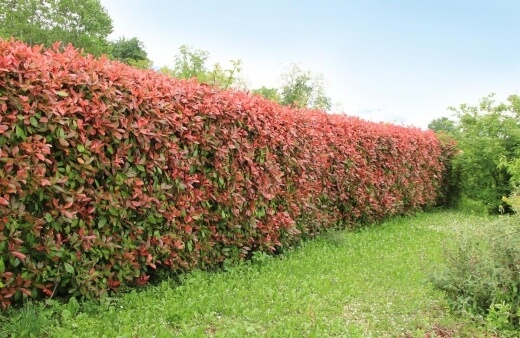
This shrub doesn’t suffer too much with pests or diseases if it’s well looked after. Since it's part of the rose family, it can be prone to some of the same ailments as roses. Let’s look at a few of these below.
Black Vine Weevil
This beetle eats many different plants and is very active in the spring and summer months. They munch on the leaves of the shrub at night. The beetle larvae then take over for the autumn and winter time, feeding on the roots of the plant.
When the roots are under great attack, you might notice that your shrub is not looking very healthy. Diatomaceous earth sprinkled over the leaves and around the base of your shrub is probably the easiest way to put black vine weevil in their place.
Fireblight
Fireblight is an absolutely terrible disease to deal with because of the way it spreads. The disease goes after certain plants in the rose family and seems to favour the ones that have flowers in summer.
It’s possible to wipe out an entire garden in one season and it spreads so easily because it can be carried by birds, insects, and even gardening tools.
Unfortunately there is no cure for fireblight and you’ll need to remove the affected plant. The bacteria is contained in the plant so you don’t need to worry about soil contamination. You’ll need to propagate and cultivate again from scratch.
Leaf Spot
Leaf spot disease can be caused by fungi, bacteria, viruses and even damage to the plant. The fungal spots usually have visible black bits or the spots might be discoloured.
The good news is that this disease isn’t a threat to your shrub. Aside from blotchy leaves, your plant might also start to lose its leaves.
When it comes to treatment, you can use a general purpose garden fungicide but you also want to help minimise spread and future infections. Check your soil drainage and make sure the plant can get enough air circulation.
Spotty or diseased leaves can be snipped off and thrown away. For pests like scale and mites, you can use neem oil or a horticultural spray which should do the trick.
Red Robins Frequently Asked Questions
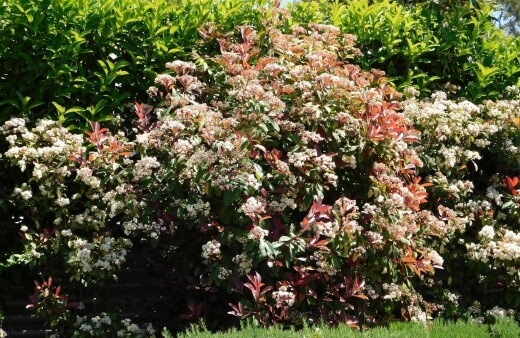
If you are planning to plant a Photinia ‘Red Robin’ hedge, how far apart do the individual shrubs need to be?
You’ll need to space the plants roughly 75cm apart. If there is a wall or fence involved, plant the shrub about 60cm away from it.
I want to get my Photinia ‘Red Robin’ to bloom. How do I do this?
This shrub produces gorgeous red leaves which is generally why you would prune – to promote that new growth and enjoy the marvellous colour of the leaves. Pruning does however limit the flowers which are pretty but rather smelly.
Some gardeners want the plant to produce flowers so they can get to the fruits that arrive afterwards. If that’s the case, you need to only prune in the winter time.
Ensuring the plant gets enough sun and shelter is important. It’s wonderful to see the little red fruits in winter and of course the birds will thank you too.
Does the Photinia ‘Red Robin’ have deep roots?
The roots of this shrub are not deep during the first year which is why you need to water quite regularly. After that, the roots are more established and the plant can manage just fine with minimal watering.
What are other great shrubs to plant together with a Photinia ‘Red Robin’?
The creeping plant Fortune’s Spindle is quite similar in shape and size if you’re looking to match up plants. Hebes are another great option.
With Photinia ‘Red Robin’ being a hybrid, what are the parent species?
It is a hybrid between Photinia glabra (the Japanese Photinia) and Photinia serratifolia (Chinese Photinia).
How fast does a Photinia ‘Red Robin’ grow?
This shrub grows about 30cm per year.
If reading about all things gardening related is your favourite thing to do, sign up for our newsletter for advice, reviews, plant profiles and more.
Enjoy Vibrant Photinia ‘Red Robin’ Hedge Surrounding Your Garden
Photinia ‘Red Robin’ are one of those shrubs that give you a warm welcome. Whilst growing your hedge or garden screen, you get to enjoy brilliant red hues with every flush of new leaf growth.
The green and red leaf contrast together are very pleasing on the eye, and because this shrub is also drought tolerant, you’re in for minimal effort for maximum enjoyment.
If you want the best looking ‘fence’ in the neighbourhood, it’s worth investing in (and propagating) your own this plant. We’re giving red robins our green thumbs up!
Published on August 6, 2022 by Maisie Blevins
Last Updated on February 22, 2024




